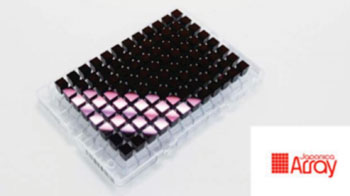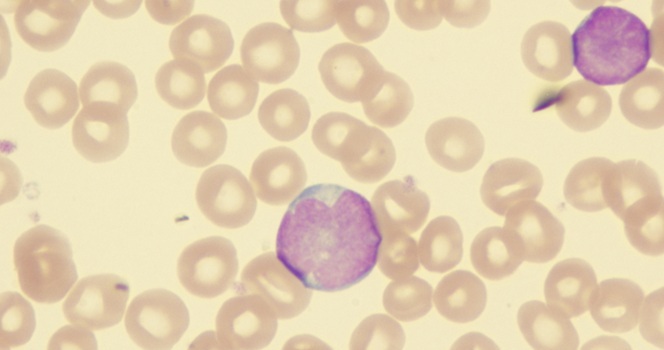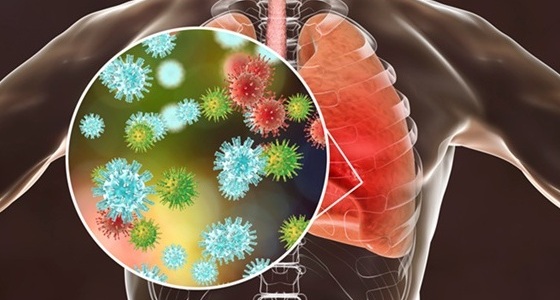Custom-Designed SNP Array Facilitates Japanese Genomic Studies
|
By LabMedica International staff writers Posted on 16 Sep 2015 |

Image: The \"Japonica Array\" contains 659,253 SNPs, including tag SNPs for imputation, SNPs of Y chromosome and mitochondria, and SNPs related to previously reported genome-wide association studies and pharmacogenomics (Photo courtesy of Tohoku Medical Megabank Organization).
Japanese genomic researchers have created a single nucleotide polymorphism (SNP) array optimized for studies on the Japanese population.
The so-called "Japonica Array" was designed by investigators at the Tohoku University Tohoku Medical Megabank Organization (Sendai, Japan). As source material, the investigators used the Tohoku Medical Megabank Organization's reference panel (referred to as the 1KJPN panel), which contains more than 20 million SNPs from whole-genome sequence data from 1070 Japanese individuals. The 1KJPN panel contains the largest number of haplotypes of Japanese ancestry to date.
Beginning with the 1KJPN panel, the investigators designed a novel custom-made SNP array, containing 659,253 SNPs, including tag SNPs for imputation, SNPs of Y- chromosome and mitochondria, and SNPs related to previously reported genome-wide association studies and pharmacogenomics.
The Japonica Array was found to provide better imputation performance for Japanese individuals than the existing commercially available SNP arrays. Imputation is an information science technique for estimating the genotype of several millions of unmeasured SNPs with a SNP array by combining it with a reference panel.
The genomic coverage of the Japonica Array was 96.9% for common SNPs; that is, almost all common SNPs were covered by this array. Furthermore, the coverage of low-frequency SNPs reached 67.2%, which was higher than those of other existing arrays.
The investigators confirmed the high quality genotyping performance of the Japonica array using the 288 samples from the 1KJPN reference panel. Results obtained from genotype screening with a high-throughput sequencer yielded an average call rate of 99.7% and an average concordance rate of 99.7%. Thus, the creation of custom-made SNP arrays based on a population-specific reference panel was shown to be a practical way to facilitate further association studies through genome-wide genotype imputations.
The study was published in the June 25, 2015, online edition of the Journal of Human Genetics.
Related Links:
Tohoku University Tohoku Medical Megabank Organization
The so-called "Japonica Array" was designed by investigators at the Tohoku University Tohoku Medical Megabank Organization (Sendai, Japan). As source material, the investigators used the Tohoku Medical Megabank Organization's reference panel (referred to as the 1KJPN panel), which contains more than 20 million SNPs from whole-genome sequence data from 1070 Japanese individuals. The 1KJPN panel contains the largest number of haplotypes of Japanese ancestry to date.
Beginning with the 1KJPN panel, the investigators designed a novel custom-made SNP array, containing 659,253 SNPs, including tag SNPs for imputation, SNPs of Y- chromosome and mitochondria, and SNPs related to previously reported genome-wide association studies and pharmacogenomics.
The Japonica Array was found to provide better imputation performance for Japanese individuals than the existing commercially available SNP arrays. Imputation is an information science technique for estimating the genotype of several millions of unmeasured SNPs with a SNP array by combining it with a reference panel.
The genomic coverage of the Japonica Array was 96.9% for common SNPs; that is, almost all common SNPs were covered by this array. Furthermore, the coverage of low-frequency SNPs reached 67.2%, which was higher than those of other existing arrays.
The investigators confirmed the high quality genotyping performance of the Japonica array using the 288 samples from the 1KJPN reference panel. Results obtained from genotype screening with a high-throughput sequencer yielded an average call rate of 99.7% and an average concordance rate of 99.7%. Thus, the creation of custom-made SNP arrays based on a population-specific reference panel was shown to be a practical way to facilitate further association studies through genome-wide genotype imputations.
The study was published in the June 25, 2015, online edition of the Journal of Human Genetics.
Related Links:
Tohoku University Tohoku Medical Megabank Organization
Latest BioResearch News
- Genome Analysis Predicts Likelihood of Neurodisability in Oxygen-Deprived Newborns
- Gene Panel Predicts Disease Progession for Patients with B-cell Lymphoma
- New Method Simplifies Preparation of Tumor Genomic DNA Libraries
- New Tool Developed for Diagnosis of Chronic HBV Infection
- Panel of Genetic Loci Accurately Predicts Risk of Developing Gout
- Disrupted TGFB Signaling Linked to Increased Cancer-Related Bacteria
- Gene Fusion Protein Proposed as Prostate Cancer Biomarker
- NIV Test to Diagnose and Monitor Vascular Complications in Diabetes
- Semen Exosome MicroRNA Proves Biomarker for Prostate Cancer
- Genetic Loci Link Plasma Lipid Levels to CVD Risk
- Newly Identified Gene Network Aids in Early Diagnosis of Autism Spectrum Disorder
- Link Confirmed between Living in Poverty and Developing Diseases
- Genomic Study Identifies Kidney Disease Loci in Type I Diabetes Patients
- Liquid Biopsy More Effective for Analyzing Tumor Drug Resistance Mutations
- New Liquid Biopsy Assay Reveals Host-Pathogen Interactions
- Method Developed for Enriching Trophoblast Population in Samples
Channels
Clinical Chemistry
view channel
Chemical Imaging Probe Could Track and Treat Prostate Cancer
Prostate cancer remains a leading cause of illness and death among men, with many patients eventually developing resistance to standard hormone-blocking therapies. These drugs often lose effectiveness... Read more
Mismatch Between Two Common Kidney Function Tests Indicates Serious Health Problems
Creatinine has long been the standard for measuring kidney filtration, while cystatin C — a protein produced by all human cells — has been recommended as a complementary marker because it is influenced... Read moreMolecular Diagnostics
view channel
Simple Urine Test to Revolutionize Bladder Cancer Diagnosis and Treatment
Bladder cancer is one of the most common and deadly urological cancers and is marked by a high rate of recurrence. Diagnosis and follow-up still rely heavily on invasive cystoscopy or urine cytology, which... Read more
Blood Test to Enable Earlier and Simpler Detection of Liver Fibrosis
Persistent liver damage caused by alcohol misuse or viral infections can trigger liver fibrosis, a condition in which healthy tissue is gradually replaced by collagen fibers. Even after successful treatment... Read moreHematology
view channel
Platelet Activity Blood Test in Middle Age Could Identify Early Alzheimer’s Risk
Early detection of Alzheimer’s disease remains one of the biggest unmet needs in neurology, particularly because the biological changes underlying the disorder begin decades before memory symptoms appear.... Read more
Microvesicles Measurement Could Detect Vascular Injury in Sickle Cell Disease Patients
Assessing disease severity in sickle cell disease (SCD) remains challenging, especially when trying to predict hemolysis, vascular injury, and risk of complications such as vaso-occlusive crises.... Read more
ADLM’s New Coagulation Testing Guidance to Improve Care for Patients on Blood Thinners
Direct oral anticoagulants (DOACs) are one of the most common types of blood thinners. Patients take them to prevent a host of complications that could arise from blood clotting, including stroke, deep... Read moreImmunology
view channel
New Test Distinguishes Vaccine-Induced False Positives from Active HIV Infection
Since HIV was identified in 1983, more than 91 million people have contracted the virus, and over 44 million have died from related causes. Today, nearly 40 million individuals worldwide live with HIV-1,... Read more
Gene Signature Test Predicts Response to Key Breast Cancer Treatment
DK4/6 inhibitors paired with hormone therapy have become a cornerstone treatment for advanced HR+/HER2– breast cancer, slowing tumor growth by blocking key proteins that drive cell division.... Read more
Chip Captures Cancer Cells from Blood to Help Select Right Breast Cancer Treatment
Ductal carcinoma in situ (DCIS) accounts for about a quarter of all breast cancer cases and generally carries a good prognosis. This non-invasive form of the disease may or may not become life-threatening.... Read moreMicrobiology
view channel
Rapid Diagnostic Test Matches Gold Standard for Sepsis Detection
Sepsis kills 11 million people worldwide every year and generates massive healthcare costs. In the USA and Europe alone, sepsis accounts for USD 100 billion in annual hospitalization expenses.... Read moreRapid POC Tuberculosis Test Provides Results Within 15 Minutes
Tuberculosis remains one of the world’s deadliest infectious diseases, and reducing new cases depends on identifying individuals with latent infection before it progresses. Current diagnostic tools often... Read more
Rapid Assay Identifies Bloodstream Infection Pathogens Directly from Patient Samples
Bloodstream infections in sepsis progress quickly and demand rapid, precise diagnosis. Current blood-culture methods often take one to five days to identify the pathogen, leaving clinicians to treat blindly... Read morePathology
view channel
Tunable Cell-Sorting Device Holds Potential for Multiple Biomedical Applications
Isolating rare cancer cells from blood is essential for diagnosing metastasis and guiding treatment decisions, but remains technically challenging. Many existing techniques struggle to balance accuracy,... Read moreAI Tool Outperforms Doctors in Spotting Blood Cell Abnormalities
Diagnosing blood disorders depends on recognizing subtle abnormalities in cell size, shape, and structure, yet this process is slow, subjective, and requires years of expert training. Even specialists... Read moreTechnology
view channel
Artificial Intelligence Model Could Accelerate Rare Disease Diagnosis
Identifying which genetic variants actually cause disease remains one of the biggest challenges in genomic medicine. Each person carries tens of thousands of DNA changes, yet only a few meaningfully alter... Read more
AI Saliva Sensor Enables Early Detection of Head and Neck Cancer
Early detection of head and neck cancer remains difficult because the disease produces few or no symptoms in its earliest stages, and lesions often lie deep within the head or neck, where biopsy or endoscopy... Read moreIndustry
view channel
Abbott Acquires Cancer-Screening Company Exact Sciences
Abbott (Abbott Park, IL, USA) has entered into a definitive agreement to acquire Exact Sciences (Madison, WI, USA), enabling it to enter and lead in fast-growing cancer diagnostics segments.... Read more
























